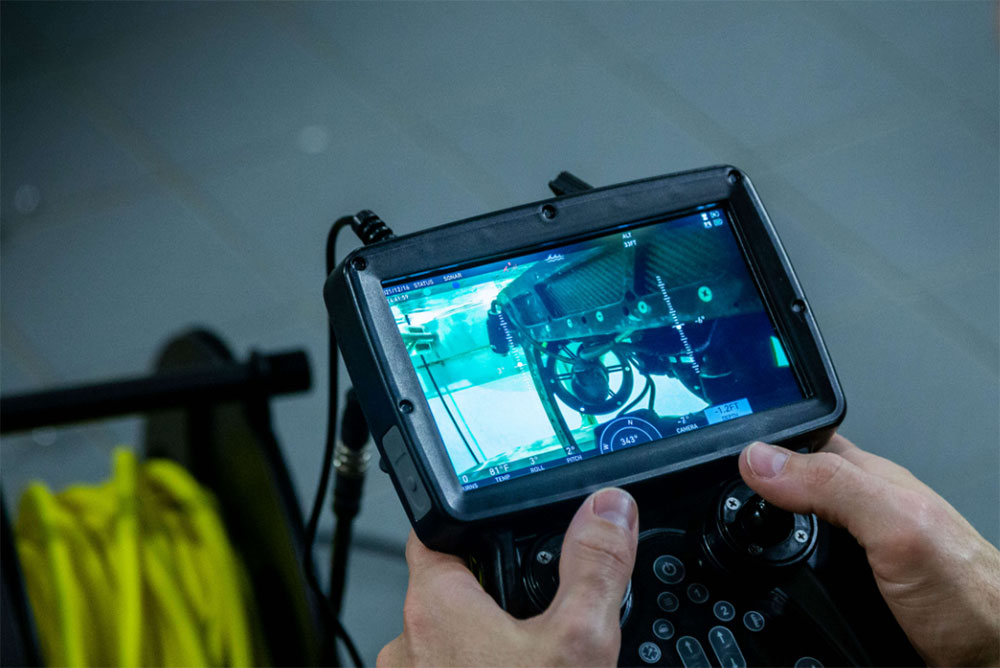
Underwater ROVs (Remotely Operated Vehicles) are submersible, robotic systems, used to observe the depths of large bodies of water by operators from shore, or by divers in the water.
A work class ROV is used for ocean floor exploration and inspections at depths that divers are often unable to reach. They act as a safe alternative to divers and are often used in offshore energy projects and deep archaeological investigations. The typical depth rating for a Work Class ROV ranges from 3,000 meters (9,800 feet) to 6,000 meters (19,700 feet).
A light work class ROV is ideal for moderate to deep depths; the ROV is deployed from ships in lieu of divers to explore. It can be used during inspections to make repairs. Large extensions, such as laser scanners or specialized inspection devices and sensors, can be added on. The depth rating for Light Work Class ROVs falls within the range of 1,000 meters (3,280 feet) to 3,000 meters (9,800 feet).
An Observation Class ROV is small in size, used to explore lakes, rivers and coastal waters. They are often used to test water safety prior to a diver entering the water during missions and conducting inspections. Able to be equipped with sonar and custom sensors, they are versatile vehicles. The depth rating for Observation Class ROVs depending on the model, typically ranges from 300 meters (984 feet) to 1,000 meters (3,280 feet).
Benefits of the Modern Underwater ROV
Due to its compact design and easy to use inspection technology, underwater ROVs can be deployed in a moment’s notice. This is highly beneficial in emergency situations where time is limited, and in areas that are too narrow or difficult to reach by divers. Deep Trekker ROVs can be deployed in as little as 30 seconds.
Underwater ROVs are robust and rugged in design, built to withstand harsh water environments, and require minimal maintenance. Typically, ROVs can last years without the need for major repairs.
Aquaculture is a key source of food, nutrition, income and livelihoods for millions of people around the globe. Using an ROV allows operators to take control of their fish farms. ROVs are used in aquaculture for a more efficient performance of net inspections, lighting, feeding, trouble shooting and stock monitoring. The use of underwater ROVs has proven to be a cost effective way for fish farmers to ensure healthy fish crop, efficient harvest and environmental protection in a variety of weather conditions.
ROVs are a versatile tool for commercial divers to perform inspections in enclosed spaces, including water tanks, pipes and intake structures or in open water applications, such as hull inspections or salvage operations. Using an ROV allows diver teams to examine a site prior to diving or send the ROV into dangerous conditions in lieu of divers to keep humans safe.
Routine inspections are critical to the long-term care and success of any type of infrastructure. With underwater infrastructure, routine inspections such as dam, reservoir and bridge inspections can be both difficult and dangerous. ROVs are now being used to perform pipeline inspections of infrastructure systems so that divers are not put in harm's way, and crucial infrastructure is well-maintained.
Threats to security are often hidden in underwater locations, either as discarded evidence, contraband travelling on ships, or explosives placed to cause destruction. An ROV gives a safe view of threats and evidence that is hidden beneath the waves, without jeopardizing diver's safety.
ROVs are used to help with environmental research and surveying our oceans for evidence. The cost and risk for divers to perform research dives can prohibit environmental organizations from moving forward. An ROV provides a cost-effective alternative to fully utilize research grants and funding.
As the population grows, the need for efficient production and delivery of energy is becoming more pressing. All forms of energy require infrastructure underwater: wind, solar, oil and gas, nuclear, and hydroelectricity. An ROV offers an alternative to sending divers underwater to perform needed emergency or routine inspection work. ROV inspections are safe, efficient and lessen the environmental impact from periodic monitoring and inspection.
Periodic inspections of boat hulls during transit and when entering ports are a necessity to monitor: a vessel’s structural integrity, the potential transfer of an invasive species, or contraband smuggling. An ROV provides an affordable, user-friendly way to perform marine surveys, hull and ship inspections and ballast tank inspections without the need for diver intervention.